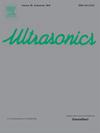基于线性复杂度的高阶延迟乘和波束形成器的生物医学被动空化映射
IF 3.8
2区 物理与天体物理
Q1 ACOUSTICS
引用次数: 0
摘要
超声诱导空化可用于多种生物医学治疗,包括局部药物递送、超声穿孔、基因转移、无创超声溶栓、碎石和组织切片。它还可以增强肿瘤的热消融,促进跨血脑屏障治疗。准确监测空化活动,包括剂量和位置,对于安全有效地应用这些疗法至关重要。被动空化映射(PCM)是实现这一目标的关键技术。然而,传统的延迟和和(DAS)波束形成方法在标准诊断超声换能器中存在低分辨率和高旁瓣电平的问题,限制了它们的有效性,或者在鲁棒型质子波束形成器(RCB)的情况下计算成本很高。为了解决这些挑战,我们提出了一种用于改进无源空化映射的高阶非线性延迟乘和(DMAS)波束形成器。我们的方法采用了一种新颖的线性复杂性实现,使用对称多项式的行列式。仿真和实验结果表明,该方法在具有线性复杂性的同时,增强了轴向和横向点扩展函数,提高了分辨率,提高了图像质量。这些改进表明,在生物医学应用中,高阶非线性波束形成是一个更准确、更可靠的空化监测的有希望的进展。本文章由计算机程序翻译,如有差异,请以英文原文为准。
Passive cavitation mapping for biomedical applications using higher order delay multiply and sum beamformer with linear complexity
Ultrasound-induced cavitation can be used in various biomedical therapies, including localized drug delivery, sonoporation, gene transfer, noninvasive sonothrombolysis, lithotripsy, and histotripsy. It can also enhance thermal ablation of tumors and facilitate trans-blood–brain-barrier treatments. Accurate monitoring of cavitation activity, including dose and location, is essential for the safe and effective application of these therapies. Passive cavitation mapping (PCM) is a key technique used to achieve this. However, conventional Delay and Sum (DAS) beamforming methods suffer from low resolution and high side-lobe levels in standard diagnostic ultrasound transducer, limiting their effectiveness or are computationally expensive, in the case of robust capon beamformer (RCB). To address these challenges, we propose a higher-order nonlinear Delay Multiply and Sum (DMAS) beamformer for improved passive cavitation mapping. Our approach utilizes a novel implementation with linear complexity, using a determinant from symmetrical polynomials. Simulation and experimental results demonstrate that the proposed method enhances both axial and lateral point spread function, resolution and increasing image quality, while exhibiting linear complexity. These improvements suggest that higher-order nonlinear beamforming is a promising advancement for more accurate and reliable cavitation monitoring in biomedical applications.
求助全文
通过发布文献求助,成功后即可免费获取论文全文。
去求助
来源期刊

Ultrasonics
医学-核医学
CiteScore
7.60
自引率
19.00%
发文量
186
审稿时长
3.9 months
期刊介绍:
Ultrasonics is the only internationally established journal which covers the entire field of ultrasound research and technology and all its many applications. Ultrasonics contains a variety of sections to keep readers fully informed and up-to-date on the whole spectrum of research and development throughout the world. Ultrasonics publishes papers of exceptional quality and of relevance to both academia and industry. Manuscripts in which ultrasonics is a central issue and not simply an incidental tool or minor issue, are welcomed.
As well as top quality original research papers and review articles by world renowned experts, Ultrasonics also regularly features short communications, a calendar of forthcoming events and special issues dedicated to topical subjects.
 求助内容:
求助内容: 应助结果提醒方式:
应助结果提醒方式:


